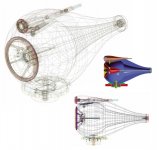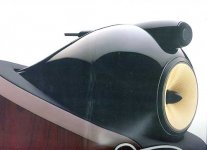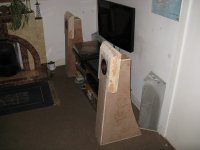Moto,
I appreciate the comments. I think the quality of the veneered plywood from Lowe's (the big box store) is suspect. Some cross cuts were fine, other edges just seemed to fall apart. It was as if there was not enough adhesive or the veneer had been stressed by wind shakes or processing during manufacture. It was a $45 lesson...I hope there is benefit in sharing it for others.
I took my time with the cuts using a 12" blade w/stiffener washers. The Powermatic table saw is used often for glue line rips. The crosscuts were made on a sliding jig made just for the purpose.
On behalf of baltic (or russian) birch, the top layer is thicker, giving more to work with in easing the edge when sanding.
I appreciate the comments. I think the quality of the veneered plywood from Lowe's (the big box store) is suspect. Some cross cuts were fine, other edges just seemed to fall apart. It was as if there was not enough adhesive or the veneer had been stressed by wind shakes or processing during manufacture. It was a $45 lesson...I hope there is benefit in sharing it for others.
I took my time with the cuts using a 12" blade w/stiffener washers. The Powermatic table saw is used often for glue line rips. The crosscuts were made on a sliding jig made just for the purpose.
On behalf of baltic (or russian) birch, the top layer is thicker, giving more to work with in easing the edge when sanding.
10" Freud Diablo from HD that was $60.
Same blade I use, I liked it so much for the $ that I bought another.
I find plywood to be hit and miss if you don't spring for BB, Marine, or some other expensive ply.
I have bought some really nice looking veneered ply which was really poor quality, lots of voids and the same separation issues. Sometimes I think they do not use enough glue / pressure.
I bought some AC ply last time, its a lot cheaper, made for roof sheathing, one good side, one not so good (knots) but if you look you can find it with two good sides. It is certainly a lot denser than the pretty veneered crappy ply and has a lot less voids so far, often I don't see any at all.
I decided to try the AC after cutting up the plywood base of a pallet which was AC ply and had no voids.
It is not what would first come to mind as speaker material but from my experience its not bad at all.
Moto,
I appreciate the comments. I think the quality of the veneered plywood from Lowe's (the big box store) is suspect. Some cross cuts were fine, other edges just seemed to fall apart. It was as if there was not enough adhesive or the veneer had been stressed by wind shakes or processing during manufacture. It was a $45 lesson...I hope there is benefit in sharing it for others.
I took my time with the cuts using a 12" blade w/stiffener washers. The Powermatic table saw is used often for glue line rips. The crosscuts were made on a sliding jig made just for the purpose.
On behalf of baltic (or russian) birch, the top layer is thicker, giving more to work with in easing the edge when sanding.
Sounds as though you have the equipment sorted then. My local lumber yard ordered my BB ply and it was nice stuff.
I haven't tried this yet, but it looks like a convenient way to reduce plywood splintering. Avoid chipout when cutting plywood — Woodsmith Tips
I haven't tried this yet, but it looks like a convenient way to reduce plywood splintering. Avoid chipout when cutting plywood — Woodsmith Tips
this definitely works like a charm - just takes twice as many passes - tradesman grade table saws like the Delta RT31 have a separate counter rotating pre-scoring blade for this purpose
Thanks for the thread everyone, it's an inspiration. Can't wait to get started!!!
Regarding the ~5-degree angle cuts – Dad suggested I gain access to a tiltable table saw. I was thinking, if I can't – Use a router? Is it possible to cut the pieces a little long, simple 90° cuts, and then jury-rig a "tilt table" for a router and rip off the angle w/ a guided bit? I can picture it - use some kind of thin-ish scrap board as the router base, then glue a stick of the right height to the bottom of the temp. base, at the right distance to the cut, so creating a 5-degree offset to the actual workpiece. Any objections?
It could even be feasible to create more precise cuts this way - going for 4.8 degree angles on a lark.
Regarding the ~5-degree angle cuts – Dad suggested I gain access to a tiltable table saw. I was thinking, if I can't – Use a router? Is it possible to cut the pieces a little long, simple 90° cuts, and then jury-rig a "tilt table" for a router and rip off the angle w/ a guided bit? I can picture it - use some kind of thin-ish scrap board as the router base, then glue a stick of the right height to the bottom of the temp. base, at the right distance to the cut, so creating a 5-degree offset to the actual workpiece. Any objections?
It could even be feasible to create more precise cuts this way - going for 4.8 degree angles on a lark.
Last edited:
your dad's right - by all means get access to the table saw - even the cheapest ones will have a tilting arbor, and you could probably cut the parts for most speaker projects in the time it takes to fabricate and calibrate a router jig (which needs accurate cuts itself - "there's a hole in the bucket dear liza - a hole" )
Just to clarify - the flat superelliptical baffles wouldn't be worth it, then? Or would they be an improvement over a suprabaffle-less setup, only not as optimal as an SB can be?
It may be. Just be aware that the abrupt edge will bring new issues to the table.
Going back to this ... if you don't mind
Edit: Picture from Sketchup:

Last edited:
Going back to this ... if you don't mind... What about rounding over the edge? (Perhaps making two baffle pieces glued together back-to-back to create a rounded edge on both sides.)
it's been my experience that a simple 45* chamfered edge is as effective as small radius on edges, and certainly a lot easier to cut ( either on the table saw or by router) - indeed, it's become somewhat of an aesthetic signature on my builds
it's been my experience that a simple 45* chamfered edge is as effective as small radius on edges, and certainly a lot easier to cut ( either on the table saw or by router) - indeed, it's become somewhat of an aesthetic signature on my builds
One more general question if you good fellows don't mind – If I have both roundover and angled guide bits for my router, suitable to the thickness, the angle is easier to cut?
Look back at page 23 of Olson. If you look at the ripple caused by the rear termination of the shape you can see that it needs to be deep to minimize ripple (ie sphere vrs half-sphere, the 2 cyliders, the other truncated shapes). The size of the edge also determines the effective transition frequency. An ideal shape is something like the mid enclosure for a B&W 800 Nautilus, and clues can be had from the shape of the helmets pursuit cyclists wear.

Nothing wrong with your aspect, i'd just make it deeper, with a larger radius.
One of the beauties thou ot the removable supraBaffle is the ability to wswap out different experiments.
dave

Nothing wrong with your aspect, i'd just make it deeper, with a larger radius.
One of the beauties thou ot the removable supraBaffle is the ability to wswap out different experiments.
dave
Look back at page 23 of Olson. If you look at the ripple caused by the rear termination of the shape you can see that it needs to be deep to minimize ripple (ie sphere vrs half-sphere, the 2 cyliders, the other truncated shapes). The size of the edge also determines the effective transition frequency. An ideal shape is something like the mid enclosure for a B&W 800 Nautilus, and clues can be had from the shape of the helmets pursuit cyclists wear.

Nothing wrong with your aspect, i'd just make it deeper, with a larger radius.
One of the beauties thou ot the removable supraBaffle is the ability to wswap out different experiments.
dave
So where does the drive unit go??
One more general question if you good fellows don't mind – If I have both roundover and angled guide bits for my router, suitable to the thickness, the angle is easier to cut?
An externally hosted image should be here but it was not working when we last tested it.
see "J" above - a thick enough square supra-baffle with 4 chamfered sides emulates a truncated pyramid on parallelopided (just for fun look that up)
I've made these as thick as 6 layers of 3/4" plywood, and cut them on table saw
Alan: I tend to locate the drivers in the center of suprabaffles, whatever their shape
So where does the drive unit go??
The magnet would impact his forehead... and you'd need to fill in the hole for his head with a symmetrical completion of the shape.
dave
Attachments
I live at approximately 5000 ft elevation, where the speed of sound is approximately 2% slower than it is at sea level. Should I scale the dimensions on the Mk3 by 2% for optimal performance?
just run your audio system on a Variac dialed for slightly higher AC mains voltage, and you should be good to go

- Home
- Loudspeakers
- Full Range
- Frugel-Horn Mk3 Builds & Build Questions


